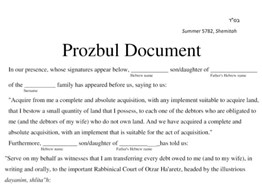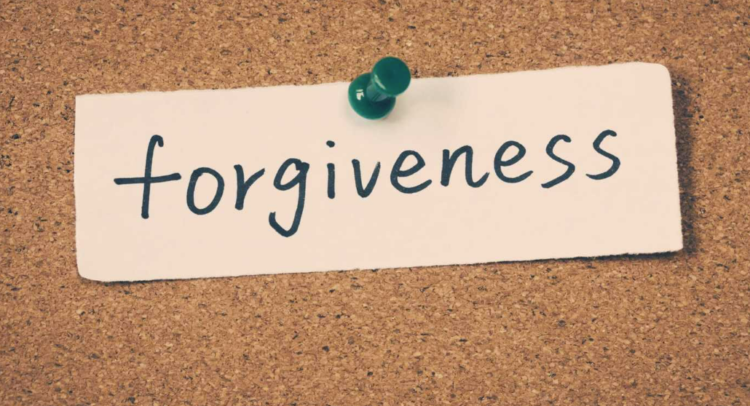Raboyseyee and Ladies,
Debt Forgiveness & A Man Named Hillel
Where was the heylige Ois this past Sunday morning, on erev Rosh Hashona mamish? In shul of course, but where specifically was he following davening? And the answer is azoy: the Ois was at the rabbi’s side waiting for him to print a copy of a blank pruzbil for the Ois to execute. And not a minute too soon: had I waited until sunset -as Rosh Hashono began- it would have been too late. Too late for what? What is a pruzbil? How does it work and why is the Ois sharing the story instead of reviewing Parshas Vayelech? Let‘s find out.
Though the heylige Ois has previously covered the pruzbil and other related topics -way back in Parshas Behar where the RBSO introduced the Yiddin to Shmita, Yoivel and other tangential concepts and mitzvis, we begin this week with a shtikel review for those who went to yeshiva, and a primer for those readers who never heard of Shmita, Yoivel, the pruzbil (and other creative loopholes) our rabbis created to improve quality of life issues and to protect the economy -specifically the banking economy- from failing. In plain English: even back in Gemora times, there were issues -in this case, borrowing and lending issues- which posed existential threats to the parnoso (livelihood) of those in the lending business. Our sages -at least one of them- understood the issue and crated a fix. He named it the “Pruzbil.”
Just last week, we talked about a fine gentleman -and much more- by the name of Ezra. You will zicher recall that Ezra, among other things, to include how often we read from the Toirah each week, also gave us dots. Not the candy: dots in the heylige Toirah. In case you missed last week’s fantastic review, you can find it at www.Oisvorfer.com. And this week, davka because Parshas Vayelech is but 30 pisukim short -an easy read, even for many of you- and davka (specifically) because the pruzbil document would no longer be valid past sunset, the Ois called an audible: instead of parsha, we will introduce Hillel, his analysis of the banking issues in Gemora times, and how he came to the rescue of lenders and borrowers.
Shoin, I see you’re mamish confused, so let us begin by rolling back the heylige Toirah to Parshas Behar where the RBSO introduced us to commandments which included Shmita and Yoivel. Says the heylige Toirah: “And Hashem spoke to Moishe b’Har Sinai (at Mount Sinai) saying… the land shall rest as a Sabbatical to Hashem as it says. “When you come to the land that I am giving you, the land must be given a rest period, a Shabbis to G-d. Ober, does land get so tired that it needs to rest? Are we farmers? How are we to internalize such information? The bottom line: if the RBSO says it’s so, who are we to argue? Veyter.
“For six years you may plant your fields, prune your vineyards, and harvest your crops, but the seventh year is a Sabbath of Sabbaths for the land. It is G-d’s Shabbis during which you may not plant your fields, nor prune your vineyards.” The sabbatical year of Shmita is called a “Shabbis,” and indeed, just as shabbis is a day of rest after six weekdays, shmita is a year of rest after six years of work. Got that? Veyter. And no matter where in the world you are, the seventh day of the week is Shabbis. One more point: Shmita is a mitzvah unique to the land of Israel. In other words, the land does not get tired outside of Israel. Why land tires only in Israel, ver veyst? Veyter.
Now that you’re all Shmita experts, let’s move on to another amazing concept: Yoivel! The Yoivel mitzvah follows immediately after Shmita and is explained as follows. Yoivel means Jubilee and the Yoivel year is known as the jubilee year. Says the heylige Toirah: “You shall count seven sabbatical years, that is, seven times seven. The period of the seven sabbatical cycles shall thus be 49 years … You shall sanctify the fiftieth year, declaring in the land an emancipation [of slaves] for the entire populace. This is your jubilee year, when each man shall return to his hereditary property and to his family”. Got that? No? Noch a mol (one more time). During Yoivel, the land may not be worked; crops are not harvested; and produce is shared by all. Moreover, the heylige Toirah (elsewhere) describes two additional aspects of Yoivel. Ershtens (firstly), the land reverts back to its original owner. Who might that be? What if he’s no longer alive? Nu, in that event, the land reverts back to its ancestral owners. And who are they? All the land in Israel is redistributed to the descendants of those who initially conquered and possessed it. Mistama we’ll have to dig them up! Mistama also, for most of you, this particular halocho is not a major concern, nor to most real estate investors, but should it be ignored? Also, on Yoivel, the slaves go free.
The bottom line: bazman hazeh (in our times) we do not mark Yoivel for a variety of reasons. As to shmita, volumes have been written and rabbis continue to argue about its observance in our times and specifically outside of Israel. Much ink continues to be spilled. And the bottom line? Aside from some plowing we attempt from time to time, if you chap, most of us are not farmers and these laws mostly do not apply to us. Oib azoy (if that’s the case), why are discussing shmita? Because in addition to land restrictions, shmita nullifies outstanding debts. It does what? It’s one thing to prohibit plowing –many barely plow anyway, if you chap, ober the nullification of debts? And the halocho (rule) is, or was azoy: at the end of a shmita year, all loans or debts between Jewish people (men or women) that are due before Rosh Hashono, are cancelled. Over and done! And guess what? It so happens that shmita observance came to an end this past Sunday evening as Rosh Hashono began. People who owed money to their friends and others, no longer owed a penny. Their debts were wiped off the books.
 Did you just read that one can borrow money from his friend, wait seven years (even less if the loan was taken closer to a shmita year) and then tell the lender that he’s not being paid because his loan expired due to shmita? Indeed, you did! This concept -an offshoot of regular shmita- is called ‘shmitas kisofim’ (a debt wipe-out, if you will). How does that work? Why should shmita wipe out a loan given? On the other hand, didn’t President Biden very recently -mamish towards the end of the current shmita year- wipe out billions of student debt? He did! Mamish on September 24th, a day before Erev Rosh Hashono, he did just that. Was he relying on the laws of shmita for cover? Ver veyst?
Did you just read that one can borrow money from his friend, wait seven years (even less if the loan was taken closer to a shmita year) and then tell the lender that he’s not being paid because his loan expired due to shmita? Indeed, you did! This concept -an offshoot of regular shmita- is called ‘shmitas kisofim’ (a debt wipe-out, if you will). How does that work? Why should shmita wipe out a loan given? On the other hand, didn’t President Biden very recently -mamish towards the end of the current shmita year- wipe out billions of student debt? He did! Mamish on September 24th, a day before Erev Rosh Hashono, he did just that. Was he relying on the laws of shmita for cover? Ver veyst?

The news gets worse: not just is the loan wiped out but one -the lender- is forbidden by a loi-sah-say (negative prohibition) from requesting repayment from the borrower. Requesting repayment of your loan after shmita, the very one you provided in good faith -out of the goodness of your heart, mamish- before the shmita year, is verboten! You are a bad person for requesting or demanding that your loan be paid. This restriction includes debts resulting from monetary loans as well as those incurred from borrowing items that have been consumed. In other words: your money and anything else you lent out are gone! Fartig and over.
On the other hand, why shouldn’t shmita wipe out your loan? Where is it written that just because you were kind enough to advance a chaver (friend) a much-needed loan, that you’re entitled to get repaid? Don’t you know that no good deed goes unpunished?! Who told you to be compassionate? It’s your own damn fault!
And list to this: debt wipeout isn’t just a minhag (custom) but a din (the law of the land, so to speak). Want more bad news? Bazman hazeh (in our times), even when the laws of Yoivel are not applicable, (according to most Halachic authorities), the mitzvah of Shmitas Kesofim (Rabbinic only) remains in effect. Why is that? Says the heylige Gemora: this was instituted so that these laws would not be forgotten from Israel. Seemingly they wanted us to forget the money but remember the laws? More bad news: it appears from the folios of the heylige Gemora that this ruling applies both in Israel and in chutz lo’oretz (here in the diaspora), since it is an obligation dependent on the person (gavrah) and not on the land (adomoh).
Shoin, what to do about this halocho? How are we to operate? Would people lend money -even at decent interest rates (that topic, also in Parshas Behar and also always relevant, for another day)- in year six (or earlier) if they understood that such loans are subject to being wiped out in year seven? A nechtiger tug and avada nisht! Fuhgeddaboudit!

Ober not to worry because our sages of the heylige Gemora -at least one of them- chapped that business is business and that the rules of Shmita and loan cancellation would mamish shut down the money lending business and efsher the gantze (entire) economy. Who would lend money under these restrictions? More specifically, who would lend out monies that were due back towards the end of a shmita year? Who would make Kol Nidrei pledges to their local shuls and who would support their local rabbis if they weren’t getting their loans repaid and couldn’t collect interest? Nobody! Ok, efsher a few, but zicher not many. What to do? Nu, when the parnosa (livelihood) of our rabbis and sages was being threatened, they sprang into action: they came up with one of the cleverer loopholes ever created and named it the Pruzbil. And Chasdei Hashem (through the kindness of the RBSO), halocho -so our rabbis teach us- makes use of “evasions” of the law in various different realms.
Ober, where is it written that one should taka lend money to those in need? Why bother with loopholes? Nu, the heylige Toirah (Devorim 15:2; 9-10) sates just so in discussing shmita and let’s learn the pisukim. “And this is the law of the shmita; to release the hand of every creditor from what he lent his friend; he shall not exact from his friend or his brother, because the time of the release for the L‑rd has arrived … Beware, lest there be in your heart an unfaithful thought, saying, “The seventh year, the year of release is approaching,” and you will begrudge your needy brother and not give him… You shall surely give him, and your heart shall not be grieved when you give to him; for because of this the L‑rd, your G‑d, will bless you in all your work and in all your endeavors.” The bottom line: lending is a must, the RBSO so ordered us to help those who need to borrow. As an aside, you just read that the RBSO was worried about us having unfaithful thoughts, even about money issues. Oy vey!
The good news: Says the heylige Gemora (Gittin) azoy: about a century before the destruction of the Second Beis Hamikdash (Temple) a man by the name of Hillel the Zoken (the elderly) came up with mamish a givaldige loophole, one of many, that allow us Yiddin to survive and thrive on a daily basis. Let us remember that the heylige Toirah does state Vochai Bohem (and you shall live by them) and avada we translate that to mean that if a law makes life so unbearable, we may find a way around it. Hillel noticed that people were avoiding lending, and because he didn’t want them to commit the avayro of not lending to those who needed help (a sin mamish described above), as the shmita year approached, he came up with this brilliant chap (novel idea).
 How does it work? Like a loophole should! The Toirah tells us that only private debts are cancelled by shmita: “He shall not exact from his friend or his brother.” Read those words again. We are not allowed to ask for our money back from our brothers, in this case the borrower. If, however, one owes money to the court (i.e., the community), shmita does not affect the loan. Based on the very specific wording of the heylige Toirah, Hillel instituted the “pruzbil,” a mechanism by which debts are magically transferred away from the individual to a Beis Din (religious court). By making a pruzbil, one makes his private debts public – and therefore redeemable. And just like that, without filing with the SEC and other regulatory, one’s private debt has gone public. Mamish gishmak! The rather simple pruzbil does the trick. Exactly how the funds are collected by the Beis Din and how they are repatriated to the original lender, ver veyst, but one has to assume that after a proper vig is paid to the Beis Din, the rest somehow makes its way back. Actually, as the Ois understands the mechanics- once the loan is declared as now belonging to the public Beis Din (with the pruzbil), one can -or at least- one may try collecting the debt himself. And as to why Hillel was allowed to enact this loophole, we are taught that there was a pressing need. The pressing need was that people were squelching on their debts and hiding behind the heylige Toirah which under the rules of shmitas-kisofim allowed them to welch on their debts. Accordingly, lenders wised up and stopped lending. Just where would the economy be without monies being borrowed and repaid? In a recession.
How does it work? Like a loophole should! The Toirah tells us that only private debts are cancelled by shmita: “He shall not exact from his friend or his brother.” Read those words again. We are not allowed to ask for our money back from our brothers, in this case the borrower. If, however, one owes money to the court (i.e., the community), shmita does not affect the loan. Based on the very specific wording of the heylige Toirah, Hillel instituted the “pruzbil,” a mechanism by which debts are magically transferred away from the individual to a Beis Din (religious court). By making a pruzbil, one makes his private debts public – and therefore redeemable. And just like that, without filing with the SEC and other regulatory, one’s private debt has gone public. Mamish gishmak! The rather simple pruzbil does the trick. Exactly how the funds are collected by the Beis Din and how they are repatriated to the original lender, ver veyst, but one has to assume that after a proper vig is paid to the Beis Din, the rest somehow makes its way back. Actually, as the Ois understands the mechanics- once the loan is declared as now belonging to the public Beis Din (with the pruzbil), one can -or at least- one may try collecting the debt himself. And as to why Hillel was allowed to enact this loophole, we are taught that there was a pressing need. The pressing need was that people were squelching on their debts and hiding behind the heylige Toirah which under the rules of shmitas-kisofim allowed them to welch on their debts. Accordingly, lenders wised up and stopped lending. Just where would the economy be without monies being borrowed and repaid? In a recession.
This pressing need is known as the ‘hefsed meruba’ (huge loss), a givaldige concept which did away with sefira and other restrictions because caterers, musicians, photographers and many others who rely on weddings, bar mitzvah’s and other events to make their living, were all suffering during the sefira period. The Ois envisions a day when shuls will allow credit cards to be swiped on shabbis following an appeal or an Aliya to the Toirah. Why not?
Efsher you remain bewildered by Hillel’s actions for who empowered him to go against what the heylige Toirah’s demands? And as you can only imagine, the Gemora has lots to say on this inyan (topic). And not just the Gemora, for generations since, they’re still discussing Hillel’s bold move, the issues and its mechanics. Says Toisfis (a commentator on the heylige Gemora) azoy: there was mamish no concept of shmita or yoivel during the 2nd Beis Hamikdash because a majority of the Yiddin were living outside of Israel. Hence Hillel did nothing wrong. Others says Hillel was not the creator of this loophole and that he was merely given credit because he publicized an already existing loophole in the Toirah which allowed private debt to be converted into court debt. In other words: Hillel, mistama the first Jew in that position, was acting like the Federal Reserve during a crisis in order to allow the banking system to work for the Yiddin. Farshteytzich (it’s plainly understood): who should it work for, the goyim? Efsher you’re wondering what will happen if and when the Moshiach arrives. Will money lending and borrowing be needed in his times? Will shmita be back? Will we need loopholes if they bring back shmita and yoivel? Is Hillel coming back? Ver veyst?
One last tidbit: There are various types of debts which do not require a pruzbil and can be collected after shmita even without the paperwork. Lemoshol (by way of example), debts which arise as a penalty or fine — such as the money a man must pay his victim for rape or seduction. You can see just how clever our sages were, they chapped even back then that some men were shlecht (bad boys) and had to make provisions for their victims to be able to collect. Also, a woman’s kesubah (marriage contract) may be enforced. There are a few others but do I expect you to concentrate once you read about seduction? Nisht (not)! Go look them up.
Back to Sunday Erev Rosh Hashono: The good rabbi -as mentioned above- did print and also witness as the Ois executed the pruzbil. What happened next? Feeling secured that the executed pruzbil was on its way into the competent hands of the Beth Din of America, on Wednesday morning, following Rosh Hashono, the Ois had the following WhatsApp exchange with a friend (let’s call him Dovy) who owes the Ois substantial monies.
Ois to friend at 11:24 AM: FYI, I signed a pruzbil on the outstanding monies.
Friend back to the Ois also at 11:24 AM: Shoot!!!! Was hoping you’d forget.
So happens that Dovy is an honest person who plans to repay his debt.
And as we close in on Yom Kippur when we seek forgiveness from the RBSO and specifically from our friends for any misdeeds, let us also recall this: lest you think that Hillel sat back and spent his days as a banker, you might be interested in knowing that our man Hillel is also credited -and correctly so says the heylige Gemora (Shabbis 31a)- with the following saying: “What is hateful to you, do not do to your fellow: this is the whole Toirah; the rest is the explanation; go and learn.” Hillel was the man!
שׁוּב מַעֲשֶׂה בְּגוֹי אֶחָד שֶׁבָּא לִפְנֵי שַׁמַּאי. אָמַר לוֹ: גַּיְּירֵנִי עַל מְנָת שֶׁתְּלַמְּדֵנִי כׇּל הַתּוֹרָה כּוּלָּהּ כְּשֶׁאֲנִי עוֹמֵד עַל רֶגֶל אַחַת! דְּחָפוֹ בְּאַמַּת הַבִּנְיָן שֶׁבְּיָדוֹ. בָּא לִפְנֵי הִלֵּל, גַּיְירֵיהּ. אָמַר לוֹ: דַּעֲלָךְ סְנֵי לְחַבְרָךְ לָא תַּעֲבֵיד — זוֹ הִיא כׇּל הַתּוֹרָה כּוּלָּהּ, וְאִידַּךְ פֵּירוּשַׁהּ הוּא, זִיל גְּמוֹר.
There was another incident involving one gentile who came before Shammai and said to Shammai: Convert me on condition that you teach me the entire Torah while I am standing on one foot. Shammai pushed him away with the builder’s cubit in his hand. This was a common measuring stick and Shammai was a builder by trade. The same gentile came before Hillel. He converted him and said to him: That which is hateful to you do not do to another; that is the entire Torah, and the rest is its interpretation. Go study.

We close with this: While Hillel gets well deserved credit for creating the form of the pruzbil, the Ois has created another form, this one the shtar michila (form of forgiveness) which will help ensure that that RBSO judges you kindly this coming Yom Kippur. You know what you did and who you pissed off. It’s time to say you are sorry. Look for it in your inbox or online this coming Sunday. The Ois will be back on Sunday with his annual form of michila (forgiveness form); look out for it in your inbox or online.
A gittin Shabbis-
The Heylige Oisvorfer Ruv
Yitz Grossman
